One of my favorite things about VMware is that it can run itself. This allows me to test & stage new setups, test API stuff on my desktop, allowing me to build a “micro data center” that I don’t need to ask & beg for permission to take down, or if I do something stupid, I’m just a quick revert away from putting it back, and more importantly not making other people mad.
This also let’s me step back in time, in this case to the dark & ancient world of 2005, where I’d first deployed VMware ESX 2.5.2 along with vCenter 1.3.1 . I figured that I could use my ancient Dell P490, as I’d been using it as a desktop at home for casual use, but this seemed like a good thing to stress the system on. Also handy to have is the installation guide, which VMware still has online.
I installed Windows 10 Pro, and VMware Player 12.5.9, The box has a single physical processor that is dual core, 8GB of RAM and a 1TB disk. Not exactly a high end machine, but it’ll suffice.
The first thing to do was install ESX 2.5.2, I’d set it up as a Linux VM, with 1 CPU, 2GB of RAM, and 3 disks, one for the OS, another for SWAP, and a Data store / Data disk.
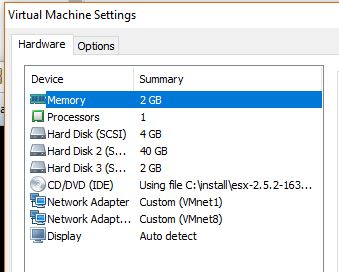
After the nice GUI setup is completed we are dumped to a console on reboot. ESX is meant to be managed remotely.
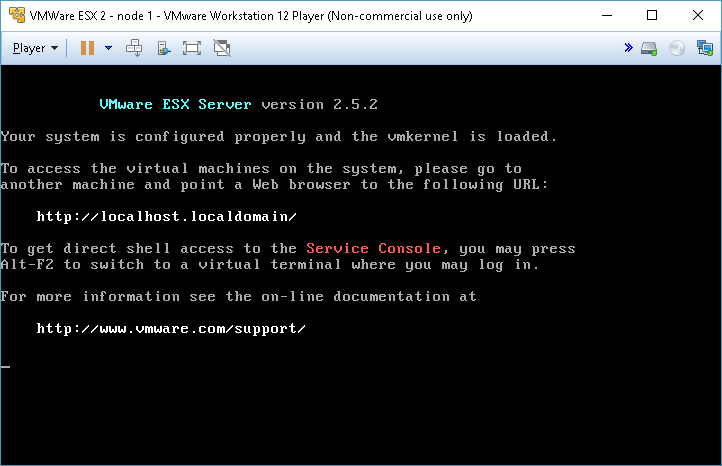
Once the OS installed, edit the VMX file, and make the following changes, to allow VMware to setup the passthrough capabilities so the VM can run other VMs.
guestOS = “vmkernel”
monitor_control.vt32 = “TRUE”
monitor_control.restrict_backdoor = “TRUE”
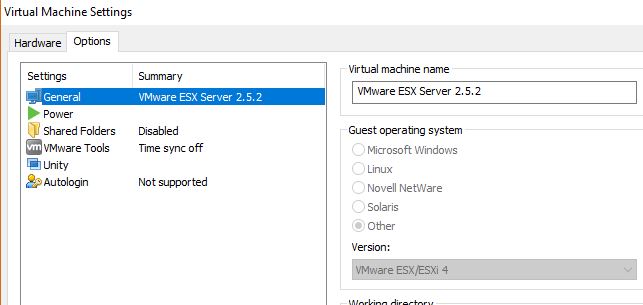
Now the Version will report that it’s VMware ESX. The other thing you’ll find out quickly is that you need a browser to manage the server (funny how things went back to this direction, later versions relied entirely on the ‘fat’ .NET client), and I found that FireFox 1.5 works the best.
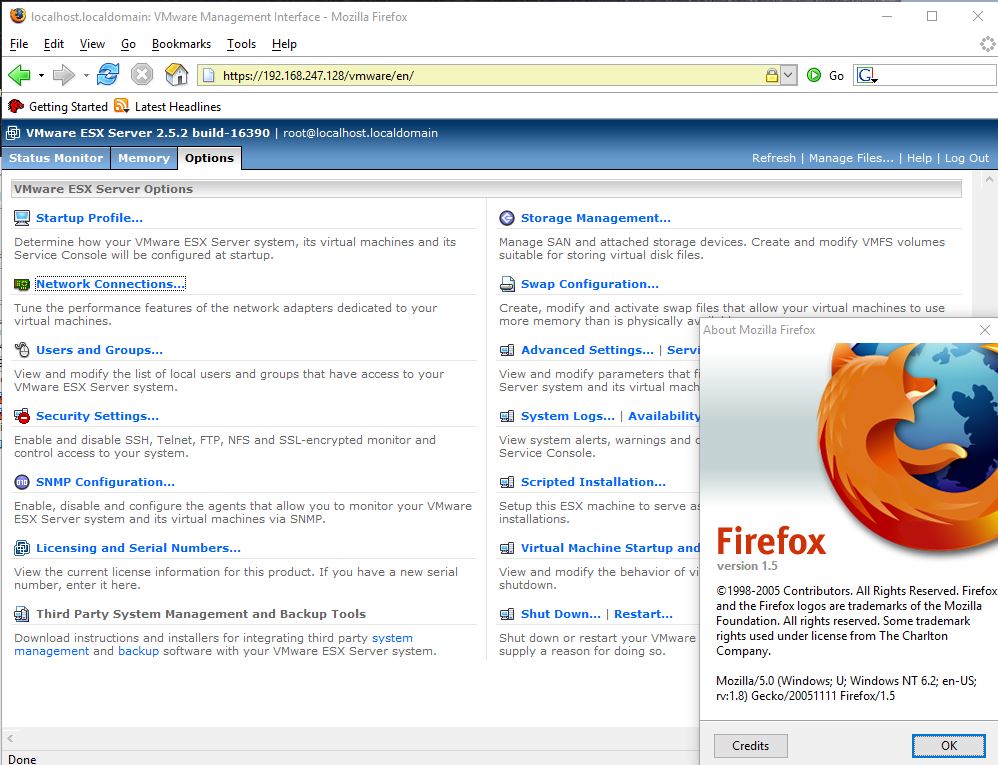
The .NET client requires .NET 1.1 to operate correctly. It will not install on Windows 10 by default, as the .NET 3.5 (which includes .NET 2.0 runtime) is not acceptable, it has to be the 1.1 runtime, along with the J# runtime, which it’ll install if needed. I went through the installation steps in the aptly name ‘Installing .NET 1.1 on Windows 10‘. post.
Of course you’ll need a place to run the vCenter server, I just setup a Windows 2000 server, installed SQL 2000, .NET v1.0 & v1.1 and then the Virtual Center component. VirtualCenter relies on a database backend, and I thought it’d be interesting to look at the tables through MSSQL, although Oracle, Access and some generic ODBC are also options for this ancient version of VirtualCenter.
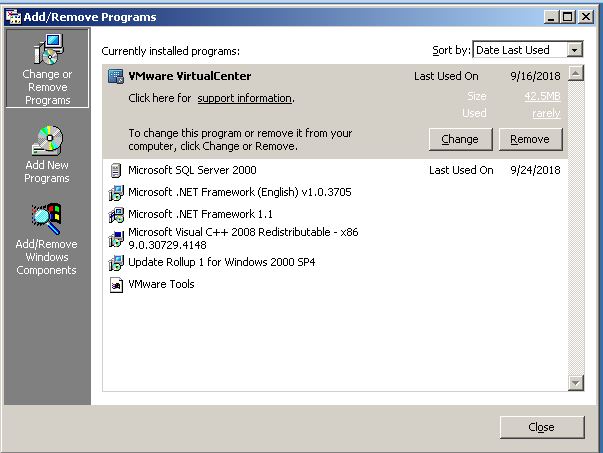
For those who don’t know, VirtualCenter is the application that lets you build a ‘virtual datacenter’ join multiple ESX servers together, and more importantly orchestrate them together into a cluster, allowing you to vMotion VMs between servers, which of course is the ‘killer feature’ of VMware ESX. If you don’t have vCenter / VirtualCenter then you are missing out on so much of the products capabilities, which is sadly hidden away.
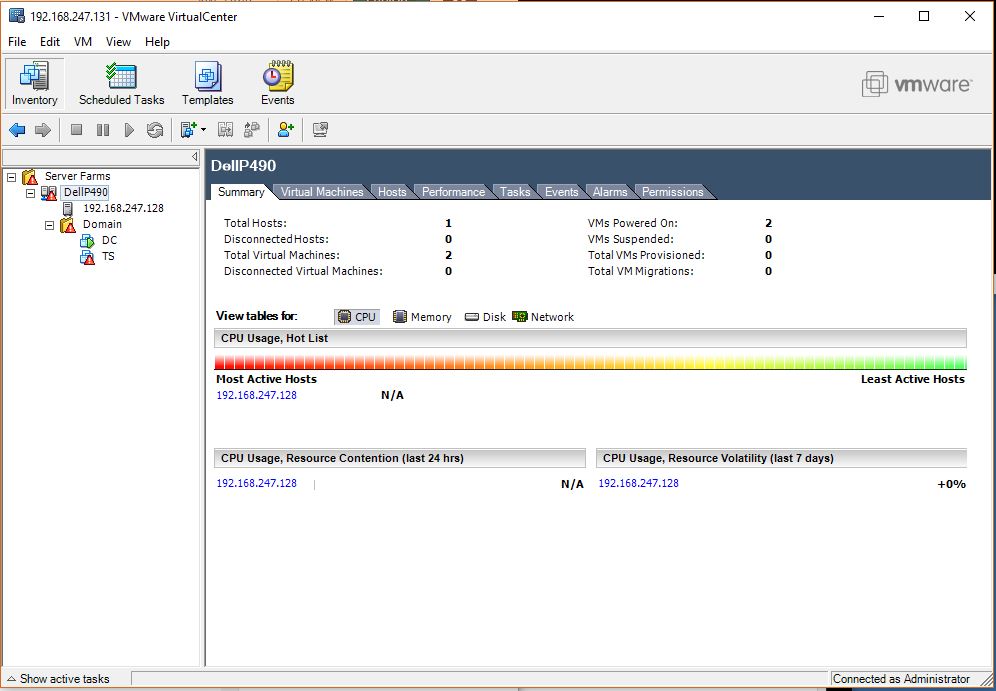
I setup a tiny Windows NT 4.0 domain, with a domain controller, and a terminal server. My host machine is a bit weak to setup more ESX hosts, as there just isn’t enough punch in the box. Although any modern machine will probably exhaust RAM before CPU running a mid 90’s workload.
Back in the day, I had moved our entire DC onto 4 ‘killer’ machines with fiber channel storage and had consolidated the entire DC to a single cabinet. It was incredible that we were initially able to almost meet existing performance. Of course the killer feature again is vMotion so a year later, I only needed 4 new servers which was an easy budget ask, and in the middle of the day I vmotioned from the old servers into the new servers, and things across the board were now faster. Finally the bean counters saw the light that we didn’t have to buy faster gear for a single group, or that we no longer had the issues where we had ‘important enough’ to be in the data center but with no hardware maintenance, or proper backups. Now everyone is on equal footing and all the boats raised with the tide so to speak.
In this quick re-visitation it would be fun to setup shared storage, multiple hosts and vMotion, but back in the days of ESX 2.5 there was no support for having VMFS over NFS or iSCSI. As much as I’d love to use the Dr Dobbs iSCSI Target Emulator, it just sadly isn’t an option. The ability to move beyond Fiber Channel shared storage (or other supported dedicated host bus adapters) was added in version 3, greatly expanding the capabilities of ESX.
Obviously the career mistake here was to be a happy Admin, and concentrate on other things as now the infrastructure ‘just worked’ and it freed up an extraordinary amount of time. The smarter people were either taking these types of experiences and turning it into a consultation gig (low effort) , or taking lessons learned in VMware space, and focusing them onto QEMU/KVM and building libre infrastructure (high effort).
Such is life, be careful riding those trendy waves, eventually you have to either lead, follow or just get out of the way.

Man, I got so fed up with trying to migrate a ESXi 4.0 server to anything newer (it had apparently been migrated from 3.x, so had some wacky partitions that 4.1 and newer refuse to touch).
I ended up getting a monsterous Dell R910 with 512GB of ram and 4x 8 core Xeons to replace the aging HP DL 360 (not sure the gen) . 20 Windows VMs and another 20 Linux containers in Proxmox VE, with tons of resources to spare. I’m on to building my third 16 drive RAID6 array now, with 16 2.5″ SAS drives internal to the R910, 16 3.5″ FC drives in a NetApp enclosure, and doubling down with a second 16 bay NetApp enclosure. Its amazing how cheap they have gotten, I ended up getting a second R910 to play with at home. The downside being when things act up, it can be almost impossible to decipher what really is wrong and Dell doesn’t share the service manual for it either.
All that to say, the old ESXi 4.0 is finally getting migrated off over the Christmas break when I can kick everyone else out for the three days to extract the .vmdk off the broken ESXi box and migrate it over to Proxmox VE, fix all the drivers and hopefully not hit any activation nonsense on our legacy database…
Lol did that after VMware 3, the guy who did the licensing was let go, and the renewal fell through.
VMware was 100% unhelpfull, so id moved everything to proxmox. It was a great fit, until both VMware dropped prices with 5, and we were bought out.
Get machines vanilla, and pre-load para virtual drivers, and for the most part you’ll be fine. I didn’t have any license issues, just MS cluster issues with shared disks… Hidden tags and shit on the volumes.
Others, yeah it works great!
Nice! Care to share where you found that ancient ESX/VCenter version? Oldest I have is 3.0.1 (https://archive.org/details/VMwareInfrastructure3-ESXServerV3.0.1)
I’d love to try out the earlier ones. GSX server too, haven’t found a copy of that so far…
I never was a fan of GSX, I should look if I have a copy of it still. At one point we had tonnes of it, prior to ESX in dev. Although I was more of a virtual server guy at the time, doing VS+Double take was pretty neat, but vmotion and making real clusters was the killer app.
I’ve seen the ISO set I have pop up on vetus once.
Yup its on vetusware
Damn, those Russians!